The Influence of Curing Temperature on the Mechanical Properties of Cement-Reinforced Sensitive Marine Clay in Column Experiments
Abstract
:1. Introduction
2. Materials and Test Procedure
2.1. Materials
2.1.1. Sensitive Marine Clays
2.1.2. Water and Binder
2.2. Mixing Procedures
2.3. Experimental Setup
2.4. Test Methods
3. Discussion and Results
3.1. Temperature Development within the Cement Clay Specimens
3.2. Influence of Curing Temperature on Stress–Strain Behavior
3.3. Influence of Curing Temperature on the UCS
3.4. The Effect of Curing Temperature on the California Bearing Ratio Value
4. Summary and Conclusions
Author Contributions
Funding
Institutional Review Board Statement
Informed Consent Statement
Data Availability Statement
Acknowledgments
Conflicts of Interest
References
- Taha, A.; Fall, M. Shear Behavior of Sensitive Marine Clay-Steel Interfaces. ACTA Geotech. 2014, 9, 969–980. [Google Scholar] [CrossRef]
- Zhou, N.; Ouyang, S.; Cheng, Q.; Ju, F. Experimental Study on Mechanical Behavior of a New Backfilling Material: Cement-Treated Marine Clay. Adv. Mater. Sci. Eng. 2019, 2019, 1261694. [Google Scholar] [CrossRef] [Green Version]
- Yi, Y.; Gu, L.; Liu, S. Microstructural and Mechanical Properties of Marine Soft Clay Stabilized by Lime-Activated Ground Granulated Blastfurnace Slag. Appl. Clay Sci. 2015, 103, 71–76. [Google Scholar] [CrossRef]
- Andersson-Sköld, Y.; Torrance, J.K.; Lind, B.; Odén, K.; Stevens, R.L.; Rankka, K. Quick Clay—A Case Study of Chemical Perspective in Southwest Sweden. Eng. Geol. 2005, 82, 107–118. [Google Scholar] [CrossRef]
- Gregersen, O.; Løken, T. The Quick-Clay Slide at Baastad, Norway, 1974. Eng. Geol. 1979, 14, 183–196. [Google Scholar] [CrossRef]
- Liu, S.Y.; Shao, G.H.; Du, Y.J.; Cai, G.J. Depositional and Geotechnical Properties of Marine Clays in Lianyungang, China. Eng. Geol. 2011, 121, 66–74. [Google Scholar] [CrossRef]
- Shen, S.-L.; Wang, Z.-F.; Yang, J.; Ho, C.-E. Generalized Approach for Prediction of Jet Grout Column Diameter. J. Geotech. Geoenviron. Eng. 2013, 139, 2060–2069. [Google Scholar] [CrossRef]
- Viswanadham, B.V.S.; Phanikumar, B.R.; Mukherjee, R.V. Swelling Behaviour of a Geofiber-Reinforced Expansive Soil. Geotext. Geomembr. 2009, 27, 73–76. [Google Scholar] [CrossRef]
- Sivakumar Babu, G.L.; Vasudevan, A.K.; Sayida, M.K. Use of Coir Fibers for Improving the Engineering Properties of Expansive Soils. J. Nat. Fibers 2008, 5, 61–75. [Google Scholar] [CrossRef]
- Yazdandoust, F.; Yasrobi, S.S. Effect of Cyclic Wetting and Drying on Swelling Behavior of Polymer-Stabilized Expansive Clays. Appl. Clay Sci. 2010, 50, 461–468. [Google Scholar] [CrossRef]
- Cheng, Y.; Huang, X. Effect of Mineral Additives on the Behavior of an Expansive Soil for Use in Highway Subgrade Soils. Appl. Sci. 2019, 9, 30. [Google Scholar] [CrossRef] [Green Version]
- Khalid, U.; Liao, C.C.; Ye, G.; Yadav, S.K. Sustainable Improvement of Soft Marine Clay Using Low Cement Content: A Multi-Scale Experimental Investigation. Constr. Build. Mater. 2018, 191, 469–480. [Google Scholar] [CrossRef]
- Tsuchida, T.; Tang, Y.X. Estimation of Compressive Strength of Cement-Treated Marine Clays with Different Initial Water Contents. Soils Found. 2015, 55, 359–374. [Google Scholar] [CrossRef] [Green Version]
- Chew, S.H.; Kamruzzaman, A.H.M.; Lee, F.H. Physicochemical and Engineering Behavior of Cement Treated Clays. J. Geotech. Geoenviron. Eng. 2004, 130, 696–706. [Google Scholar] [CrossRef]
- Ekinci, A.; Ince, C.; Ferreira, P.M.V. An Experimental Study on Compression and Shrinkage Behavior of Cement-Treated Marine Deposited Clays. Int. J. Geosynth. Ground Eng. 2019, 5, 21. [Google Scholar] [CrossRef]
- Yao, K.; Chen, Q.; Ho, J.; Xiao, H.; Lee, F.H. Strain-Dependent Shear Stiffness of Cement-Treated Marine Clay. J. Mater. Civ. Eng. 2018, 30, 04018255. [Google Scholar] [CrossRef]
- Lee, F.-H.; Lee, Y.; Chew, S.-H.; Yong, K.-Y. Strength and Modulus of Marine Clay-Cement Mixes. J. Geotech. Geoenviron. Eng. 2005, 131, 178–186. [Google Scholar] [CrossRef]
- Kamruzzaman, A.H.; Chew, S.H.; Lee, F.H. Structuration and Destructuration Behavior of Cement-Treated Singapore Marine Clay. J. Geotech. Geoenviron. Eng. 2009, 135, 573–589. [Google Scholar] [CrossRef]
- Fatahi, B.; Khabbaz, H.; Fatahi, B. Mechanical Characteristics of Soft Clay Treated with Fibre and Cement. Geosynth. Int. 2012, 19, 252–262. [Google Scholar] [CrossRef] [Green Version]
- Zhang, R.; Zheng, J.; Bian, X. Experimental Investigation on Effect of Curing Stress on the Strength of Cement-Stabilized Clay at High Water Content. Acta Geotech. 2017, 12, 921–936. [Google Scholar] [CrossRef]
- Xiao, H.; Shen, W.; Lee, F.H. Engineering Properties of Marine Clay Admixed with Portland Cement and Blended Cement with Siliceous Fly Ash. J. Mater. Civ. Eng. 2017, 29, 04017177. [Google Scholar] [CrossRef]
- Sasanian, S.; Newson, T.A. Basic Parameters Governing the Behaviour of Cement-Treated Clays. Soils Found. 2014, 54, 209–224. [Google Scholar] [CrossRef] [Green Version]
- Tremblay, H.; Leroueil, S.; Locat, J. Mechanical Improvement and Vertical Yield Stress Prediction of Clayey Soils from Eastern Canada Treated with Lime or Cement. Can. Geotech. J. 2001, 38, 567–579. [Google Scholar] [CrossRef]
- Lorenzo, G.A.; Bergado, D.T. Fundamental Parameters of Cement-Admixed Clay—New Approach. J. Geotech. Geoenviron. Eng. 2004, 130, 1042–1050. [Google Scholar] [CrossRef]
- Horpibulsk, S.; Rachan, R.; Suddeepong, A.; Chinkulkijniwat, A. Strength Development in Cement Admixed Bangkok Clay: Laboratory and Field Investigations. Soils Found. 2011, 51, 239–251. [Google Scholar] [CrossRef] [Green Version]
- Dahal, B.K.; Zheng, J.-J.; Zhang, R.-J.; Song, D.-B. Enhancing the Mechanical Properties of Marine Clay Using Cement Solidification. Mar. Georesources Geotechnol. 2019, 37, 755–764. [Google Scholar] [CrossRef]
- Mengue, E.; Mroueh, H.; Lancelot, L.; Eko, R.M. Mechanical Improvement of a Fine-Grained Lateritic Soil Treated with Cement for Use in Road Construction. J. Mater. Civ. Eng. 2017, 29, 04017206. [Google Scholar] [CrossRef]
- Sobhan, K.; Ramirez, J.C.; Reddy, D.V. Cement Stabilization of Highly Organic Subgrade Soils to Control Secondary Compression Settlement. Transp. Res. Rec. 2012, 2310, 103–112. [Google Scholar] [CrossRef]
- Athanasopoulou, A. The Role of Curing Period on the Engineering Characteristics of a Cement-Stabilized Soil. Rom. J. Transp. Infrastruct. 2016, 5, 38–52. [Google Scholar] [CrossRef] [Green Version]
- Zhang, R.J.; Santoso, A.M.; Tan, T.S.; Phoon, K.K. Strength of High Water-Content Marine Clay Stabilized by Low Amount of Cement. J. Geotech. Geoenviron. Eng. 2013, 139, 2170–2181. [Google Scholar] [CrossRef]
- Chen, S.; Xiang, Z.; Eker, H. Curing Stress Influences the Mechanical Characteristics of Cemented Paste Backfill and Its Damage Constitutive Model. Buildings 2022, 12, 1607. [Google Scholar] [CrossRef]
- Wang, D.; Zentar, R.; Abriak, N.E. Temperature-Accelerated Strength Development in Stabilized Marine Soils as Road Construction Materials. J. Mater. Civ. Eng. 2017, 29, 04016281. [Google Scholar] [CrossRef]
- Fall, M.; Celestin, J.C.; Pokharel, M.; Toure, M. A Contribution to Understanding the Effects of Curing Temperature on the Mechanical Properties of Mine Cemented Tailings Backfill. Eng. Geol. 2010, 114, 397–413. [Google Scholar] [CrossRef]
- Fall, M.; Samb, S.S. Effect of High Temperature on Strength and Microstructural Properties of Cemented Paste Backfill. Fire Saf. J. 2009, 44, 642–651. [Google Scholar] [CrossRef]
- Kondo, F.; Torrance, J.K. Effects of Smectite, Salinity and Water Content on Sedimentation and Self-Weight Consolidation of thoroughly Disturbed Soft Marine Clay. Paddy Water Environ. 2005, 3, 155–164. [Google Scholar] [CrossRef]
- Nader, A.; Fall, M.; Hache, R. Characterization of Sensitive Marine Clays by Using Cone and Ball Penetrometers: Example of Clays in Eastern Canada. Geotech. Geol. Eng. 2015, 33, 841–864. [Google Scholar] [CrossRef]
- Jafari, S.H.; Lajevardi, S.H.; Sharifipour, M.; Kamalian, M. Evaluation of Small Strain Stiffness Characteristics of Soft Clay Treated with Lime and Nanosilica and Correlation with UCS (Qu). Bull. Eng. Geol. Environ. 2021, 80, 3163–3175. [Google Scholar] [CrossRef]
- Kamińska, K.; Cholewa, M.; Moskwik, K. Impact of a Used Stabiliser on the California Bearing Ratio of the Clayey-Sandy Silt. J. Ecol. Eng. 2017, 18, 154–158. [Google Scholar] [CrossRef]
- Dai, J.; Wang, Q.; Lou, X.; Bao, X.; Zhang, B.; Wang, J.; Zhang, X. Solution Calorimetry to Assess Effects of Water-Cement Ratio and Low Temperature on Hydration Heat of Cement. Constr. Build. Mater. 2021, 269, 121222. [Google Scholar] [CrossRef]
- Wang, Y.; Fall, M.; Wu, A. Initial Temperature-Dependence of Strength Development and Self-Desiccation in Cemented Paste Backfill That Contains Sodium Silicate. Cem. Concr. Compos. 2016, 67, 101–110. [Google Scholar] [CrossRef]
- Zhang, R.J.; Lu, Y.T.; Tan, T.S.; Phoon, K.K.; Santoso, A.M. Long-Term Effect of Curing Temperature on the Strength Behavior of Cement-Stabilized Clay. J. Geotech. Geoenviron. Eng. 2014, 140, 04014045. [Google Scholar] [CrossRef]
- Zeyad, A.M.; Tayeh, B.A.; Adesina, A.; de Azevedo, A.R.G.; Amin, M.; Hadzima-Nyarko, M.; Saad Agwa, I. Review on Effect of Steam Curing on Behavior of Concrete. Clean. Mater. 2022, 3, 100042. [Google Scholar] [CrossRef]
- Gupta, D.; Kumar, A. Strength Characterization of Cement Stabilized and Fiber Reinforced Clay–Pond Ash Mixes. Int. J. Geosynth. Ground Eng. 2016, 2, 32. [Google Scholar] [CrossRef] [Green Version]
- Bascetin, A.; Adiguzel, D.; Eker, H.; Tuylu, S. The Investigation of Geochemical and Geomechanical Properties in Surface Paste Disposal by Pilot-Scale Tests. Int. J. Min. Reclam. Environ. 2022, 36, 537–551. [Google Scholar] [CrossRef]
- Shirani, S.; Cuesta, A.; Morales-Cantero, A.; De la Torre, A.G.; Olbinado, M.P.; Aranda, M.A.G. Influence of Curing Temperature on Belite Cement Hydration: A Comparative Study with Portland Cement. Cem. Concr. Res. 2021, 147, 106499. [Google Scholar] [CrossRef]
- Lothenbach, B.; Winnefeld, F.; Alder, C.; Wieland, E.; Lunk, P. Effect of Temperature on the Pore Solution, Microstructure and Hydration Products of Portland Cement Pastes. Cem. Concr. Res. 2007, 37, 483–491. [Google Scholar] [CrossRef]
- Fall, M.; Pokharel, M. Coupled Effects of Sulphate and Temperature on the Strength Development of Cemented Tailings Backfills: Portland Cement-Paste Backfill. Cem. Concr. Compos. 2010, 32, 819–828. [Google Scholar] [CrossRef]
- Fang, K.; Fall, M. Effects of Curing Temperature on Shear Behaviour of Cemented Paste Backfill-Rock Interface. Int. J. Rock Mech. Min. Sci. 2018, 112, 184–192. [Google Scholar] [CrossRef]
- Kjellsen, K.O.; Detwiler, R.J. Reaction Kinetics of Portland Cement Mortars Hydrated at Different Temperatures. Cem. Concr. Res. 1992, 22, 112–120. [Google Scholar] [CrossRef]
- Sinthaworn, S.; Nimityongskul, P. Effects of Temperature and Alkaline Solution on Electrical Conductivity Measurements of Pozzolanic Activity. Cem. Concr. Compos. 2011, 33, 622–627. [Google Scholar] [CrossRef]
- Helinski, M.; Fourie, A.; Fahey, M.; Ismail, M. Assessment of the Self-Desiccation Process in Cemented Mine Backfills. Can. Geotech. J. 2007, 44, 1148–1156. [Google Scholar] [CrossRef]
- Elkhadiri, I.; Puertas, F. The Effect of Curing Temperature on Sulphate-Resistant Cement Hydration and Strength. Constr. Build. Mater. 2008, 22, 1331–1341. [Google Scholar] [CrossRef]
- Sant, G. The Influence of Temperature on Autogenous Volume Changes in Cementitious Materials Containing Shrinkage Reducing Admixtures. Cem. Concr. Compos. 2012, 34, 855–865. [Google Scholar] [CrossRef]
- Nagaraj, H.B.; Suresh, M.R. Influence of Clay Mineralogy on the Relationship of CBR of Fine-Grained Soils with Their Index and Engineering Properties. Transp. Geotech. 2018, 15, 29–38. [Google Scholar] [CrossRef]
- Katte, V.Y.; Mfoyet, S.M.; Manefouet, B.; Wouatong, A.S.L.; Bezeng, L.A. Correlation of California Bearing Ratio (CBR) Value with Soil Properties of Road Subgrade Soil. Geotech. Geol. Eng. 2019, 37, 217–234. [Google Scholar] [CrossRef]
- Ampadu, S.I.K. A Laboratory Investigation into the Effect of Water Content on the CBR of a Subgrade Soil. In Experimental Unsaturated Soil Mechanics; Schanz, T., Ed.; Springer: Berlin/Heidelberg, Germany, 2007; pp. 137–144. [Google Scholar]
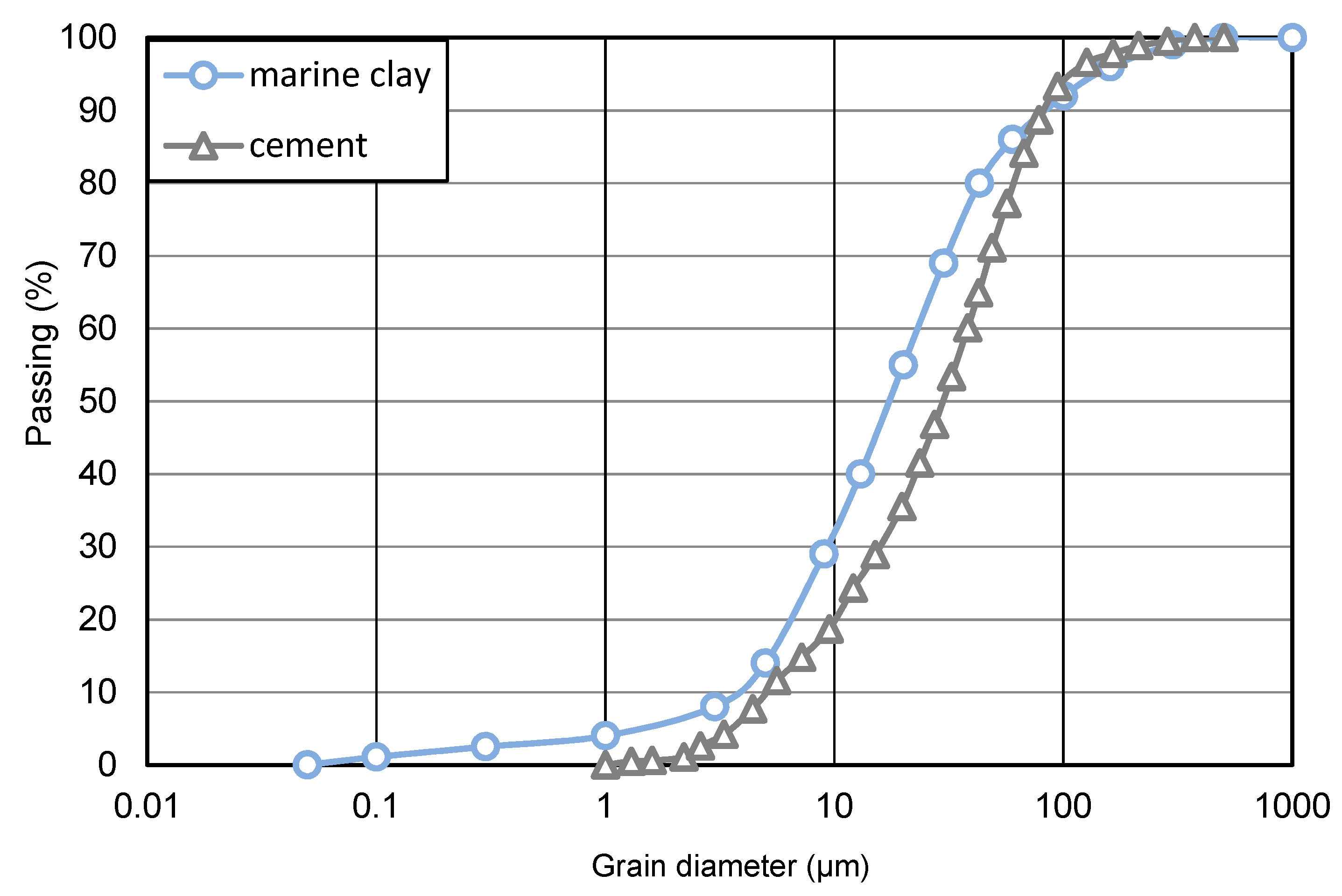
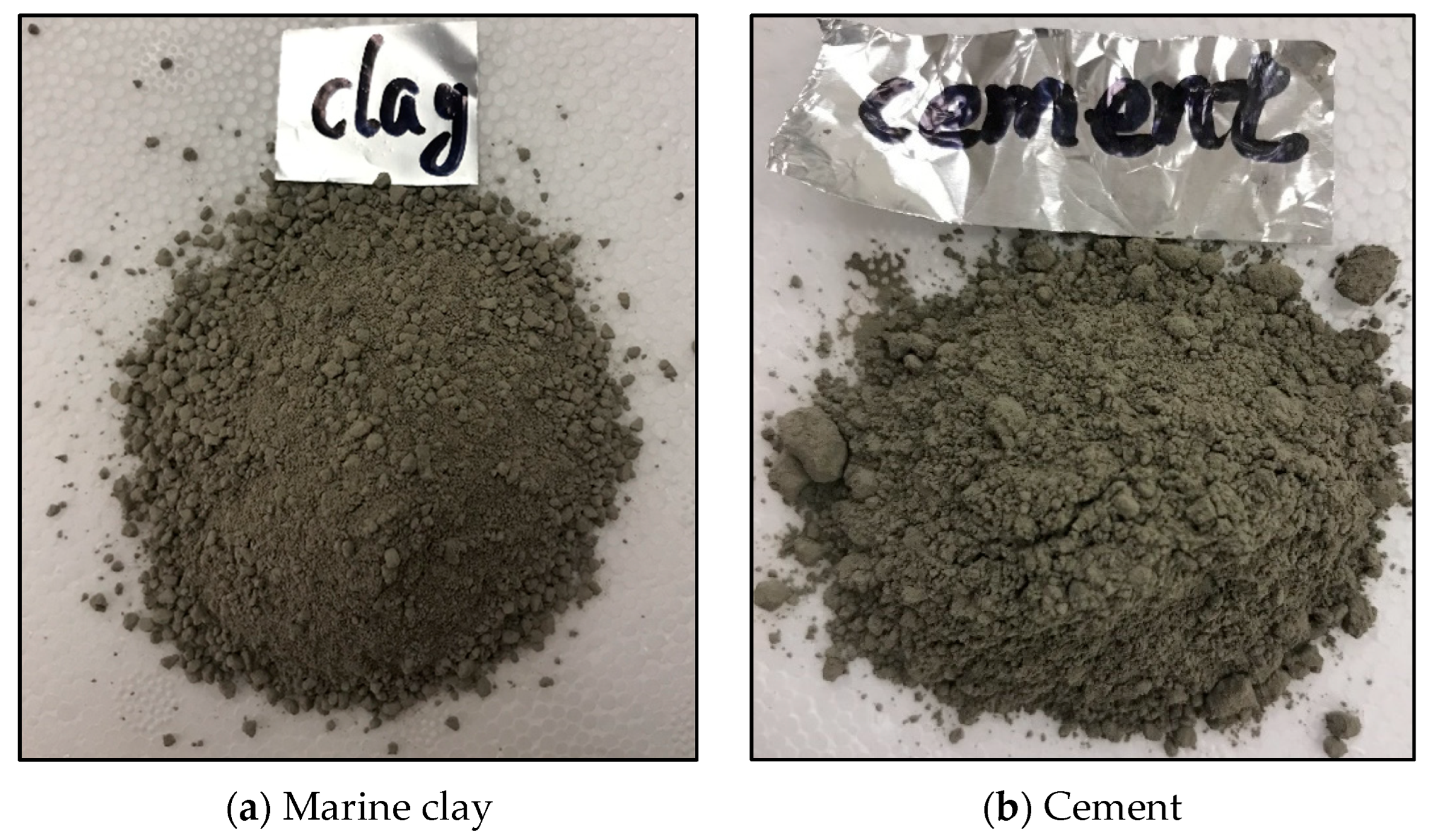
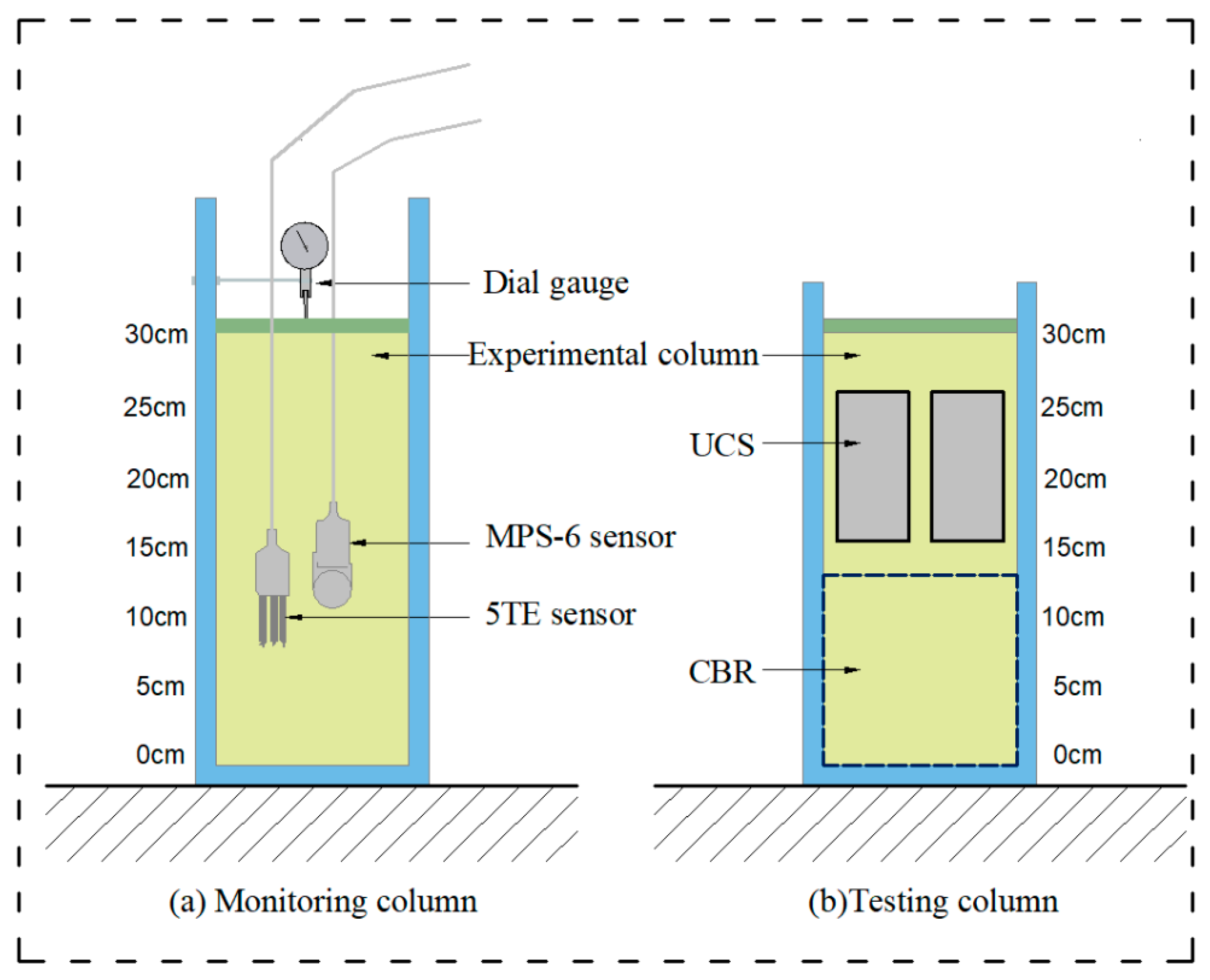
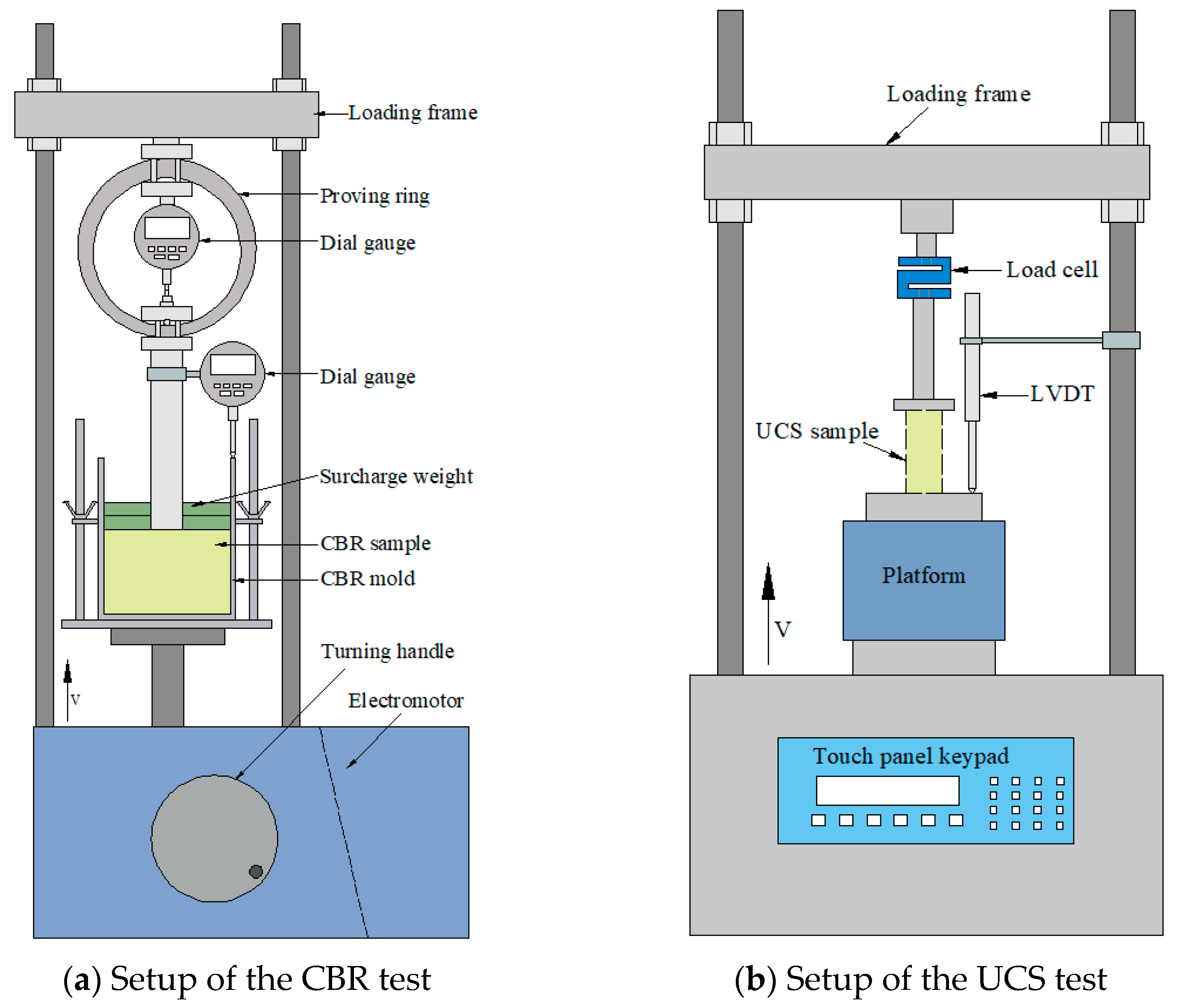
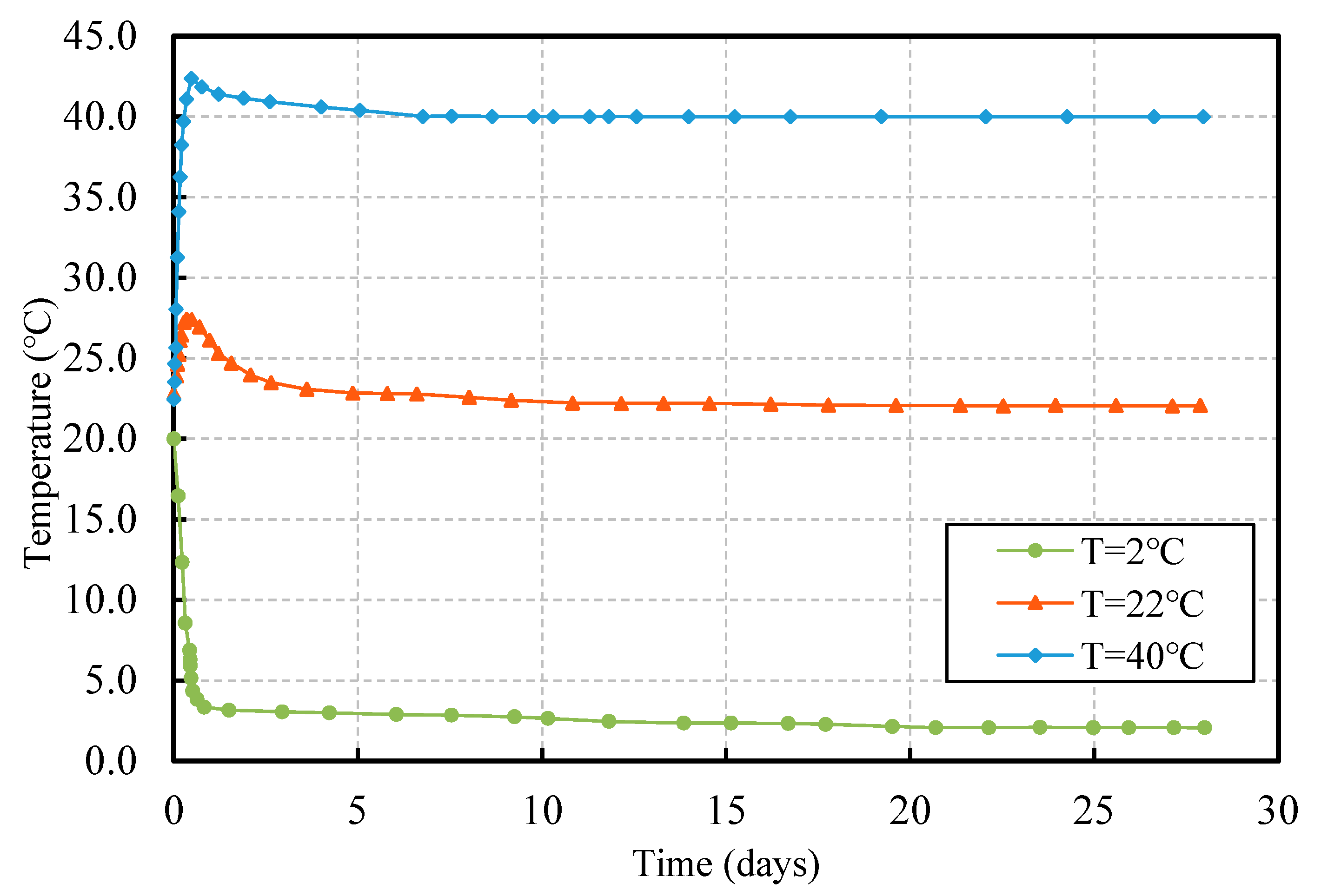
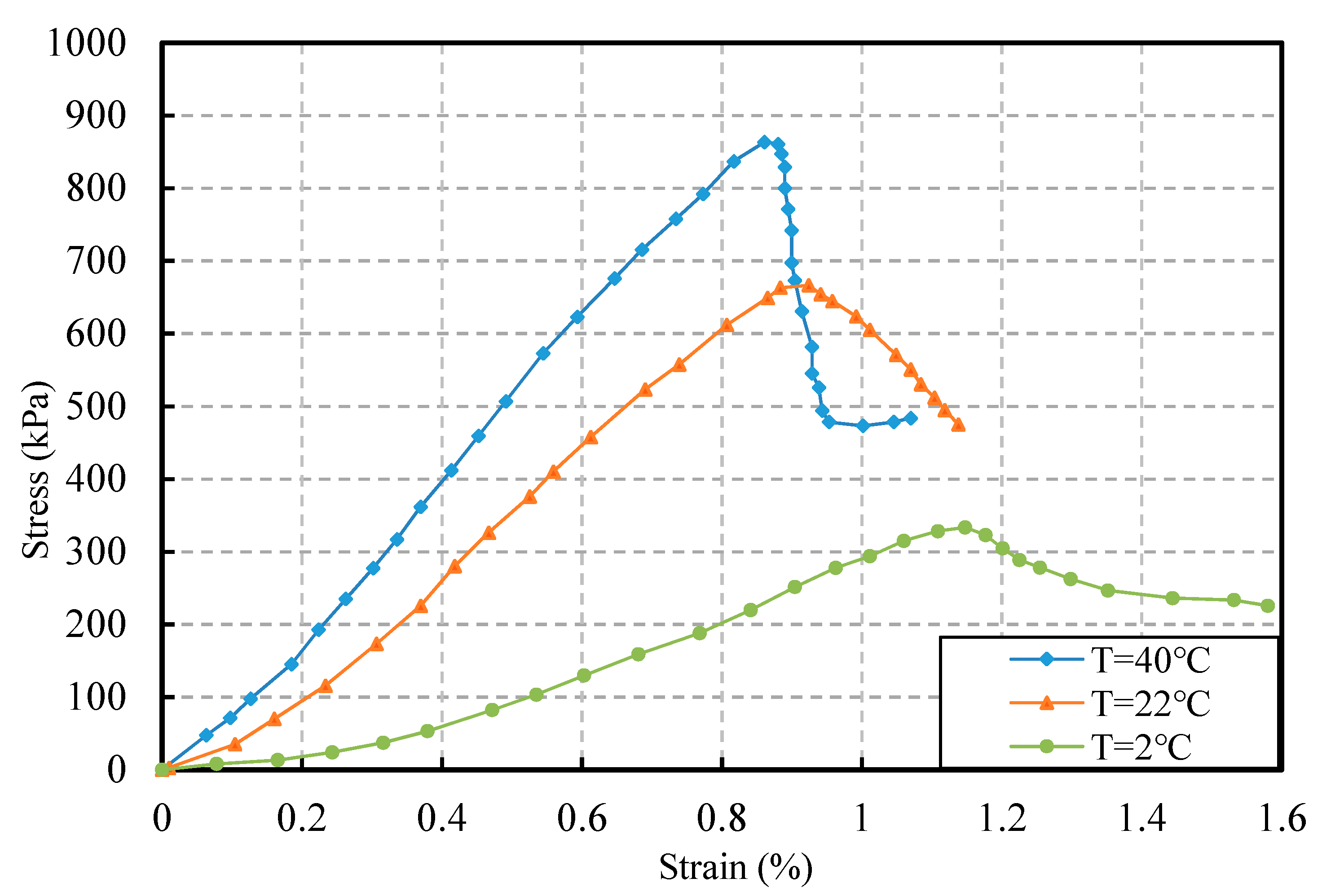
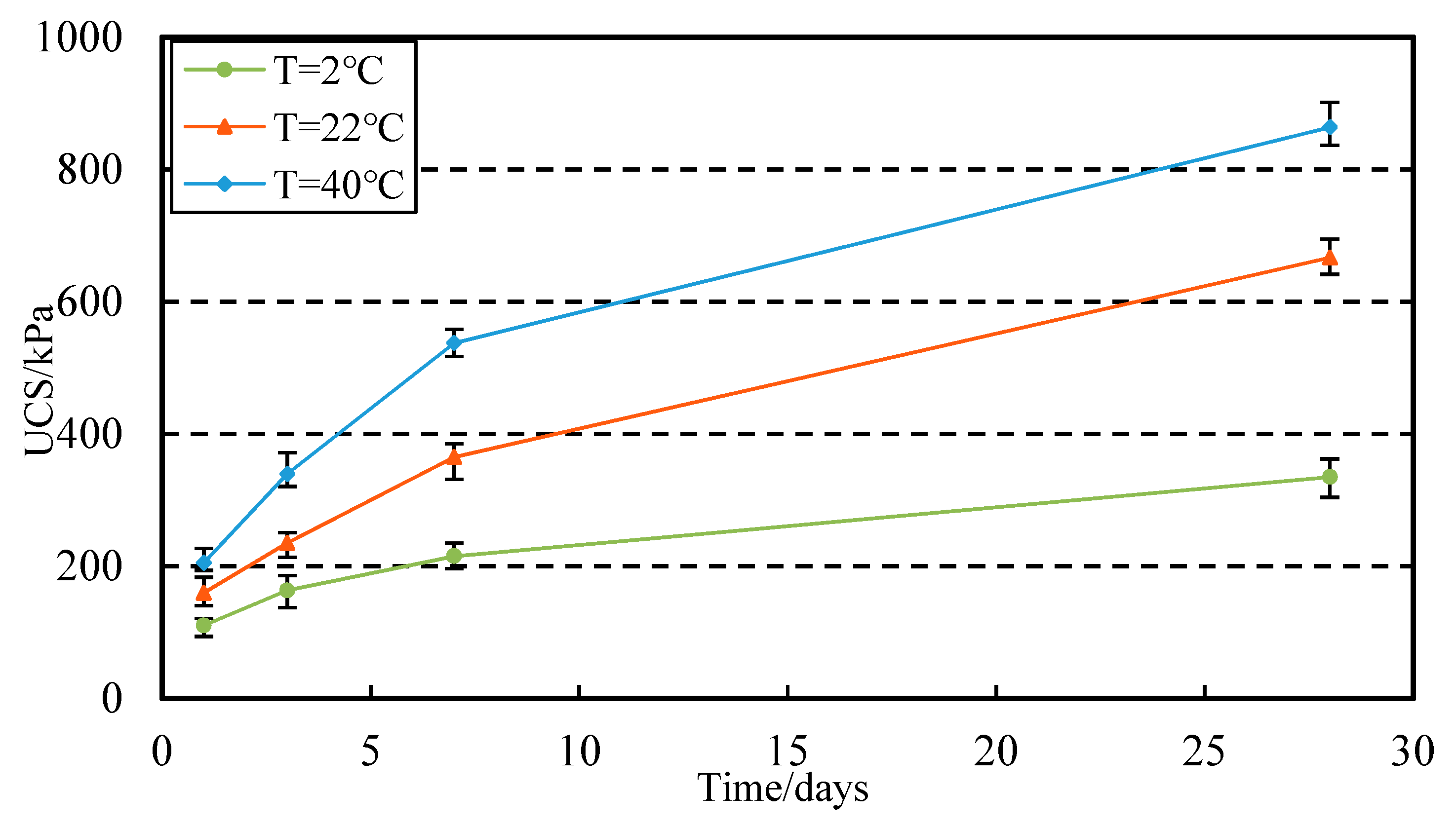
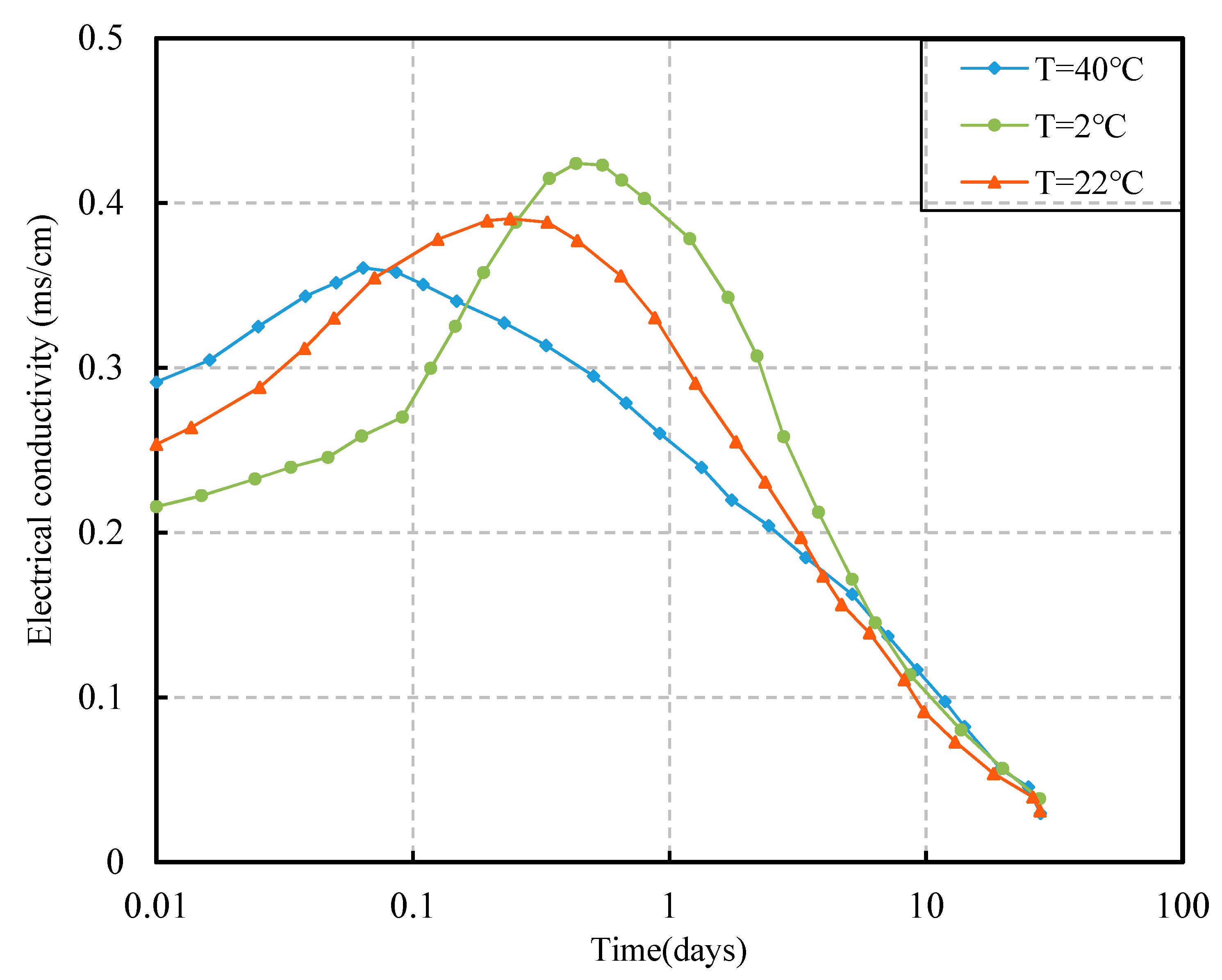

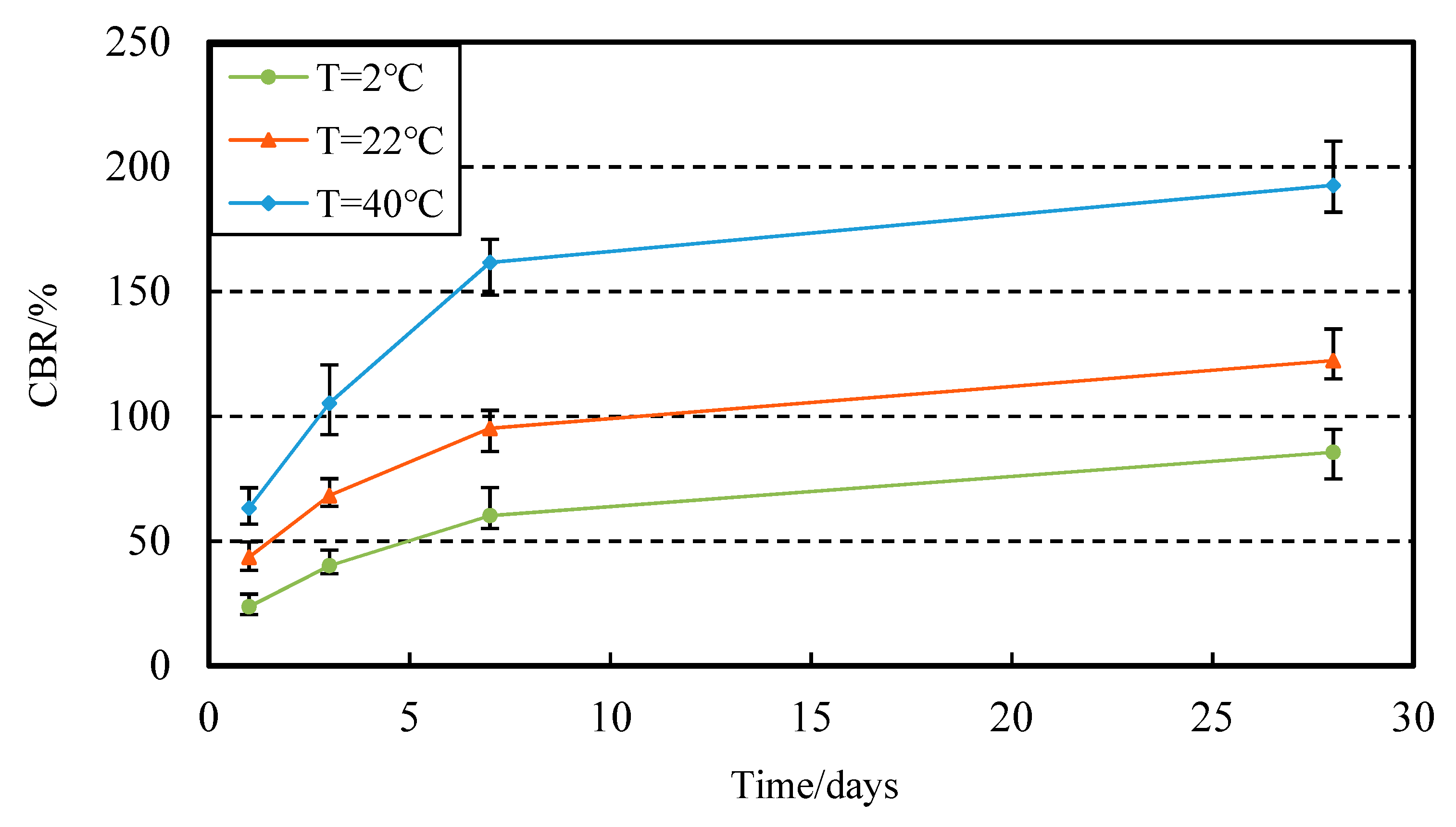
| Properties | A. Taha [1] | Athir Nader [36] | This Study |
|---|---|---|---|
| Specific gravity | 2.74–2.79 | 2.72–2.78 | |
| Water content (%) | 82 | 37–89.2 | 56.6 |
| Liquid limit (%) | 66 | 14.8–37 | 44.57 |
| Plastic limit (%) | 25 | 26.3–59.9 | 15.91 |
| Plasticity index (%) | 40 | 11.5–28.1 | 28.42 |
| Liquidity index | 1.4 | - | 1.41 |
| Natural void ratio | 2 | - | |
| Optimum water content, dry density at optimum | 22%, 1.53 g.cm3 | - | 18.91%, 1.43 g.cm3 |
| Component Unit | SO3 (wt.%) | Fe2O3 (wt.%) | Al2O3 (wt.%) | SiO2 (wt.%) | CaO (wt.%) | MgO (wt.%) |
|---|---|---|---|---|---|---|
| PCI | 3.82 | 2.70 | 4.53 | 18.03 | 62.82 | 2.65 |
Disclaimer/Publisher’s Note: The statements, opinions and data contained in all publications are solely those of the individual author(s) and contributor(s) and not of MDPI and/or the editor(s). MDPI and/or the editor(s) disclaim responsibility for any injury to people or property resulting from any ideas, methods, instructions or products referred to in the content. |
© 2023 by the authors. Licensee MDPI, Basel, Switzerland. This article is an open access article distributed under the terms and conditions of the Creative Commons Attribution (CC BY) license (https://creativecommons.org/licenses/by/4.0/).
Share and Cite
Huang, S.; Xing, R.; Zhou, C.; Chen, Q.; Hu, C.; Cao, W. The Influence of Curing Temperature on the Mechanical Properties of Cement-Reinforced Sensitive Marine Clay in Column Experiments. Sustainability 2023, 15, 11514. https://doi.org/10.3390/su151511514
Huang S, Xing R, Zhou C, Chen Q, Hu C, Cao W. The Influence of Curing Temperature on the Mechanical Properties of Cement-Reinforced Sensitive Marine Clay in Column Experiments. Sustainability. 2023; 15(15):11514. https://doi.org/10.3390/su151511514
Chicago/Turabian StyleHuang, Shaoping, Ruiming Xing, Chang Zhou, Qian Chen, Chong Hu, and Wenying Cao. 2023. "The Influence of Curing Temperature on the Mechanical Properties of Cement-Reinforced Sensitive Marine Clay in Column Experiments" Sustainability 15, no. 15: 11514. https://doi.org/10.3390/su151511514
APA StyleHuang, S., Xing, R., Zhou, C., Chen, Q., Hu, C., & Cao, W. (2023). The Influence of Curing Temperature on the Mechanical Properties of Cement-Reinforced Sensitive Marine Clay in Column Experiments. Sustainability, 15(15), 11514. https://doi.org/10.3390/su151511514






